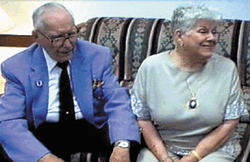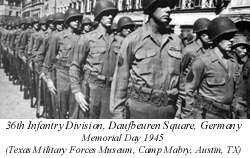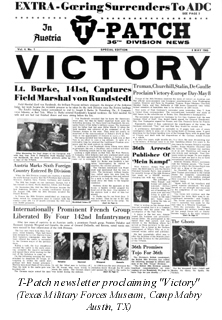|
“I wouldn't take a million dollars for the experiences I went through,
but you couldn't give me ten million to do it again.”
|
|
 |
 |
|
Fighting
with the 36th Infantry Division
|
|
|
-An
oral history of Bob Faught
|
Home | Table of Contents | Previous Story | Next Story
Personal Profile | Audio Interview
|
In
March of 1944, Bob Faught “got an order from the draft board to report for
examination for the service.” On April 25, he was officially drafted and sent
to San Antonio for induction into the Army. Bob notes that it was “two days
before my fourth wedding anniversary.” His wife, Elizabeth, who was twenty
years old at the time, still vividly recalls the fear and concern she felt
as her husband left for war. “I was scared,” she says. “Here I am just a little
young lady with two children, and my Bob spent seventeen weeks “undergoing infantry raining” at Fort Hood, Texas before he was sent to Europe to join the 36th Infantry Division. “I didn’t know whether I’d be back or not,” he remembers. Elizabeth adds, “He was called in as a replacement, so . . . he had his training and . . . was gone. We didn’t have too much time to think, it happened so fast.” In November 1944, Bob joined the 36th in France and quickly found himself immersed in battle. “My
first battle was [the] night I was put in a foxhole, November 11, 1944,” he
recounts. “The next morning was when the actual shooting really started. I
had to get out of the foxhole and pursue the enemy.” Bob spent most of World
War II, as he put it, “chasing the Germans, trying to get them, trying to
capture them to end the war.” This pursuit took Bob across France, through
Germany, and into Austria. Although Bob experienced numerous terrifying and
intense moments during his service, there were also many empty hours. “A lot
of times we [and the Germans] would sit on a defensive line for days, just
sitting there looking at each other. Then we’d get orders to take off and
go after them,” he explains. “It was always attack and counterattack—may the
best man win.” Bob vividly remembers some powerful encounters in Germany. The 36th moved into Ulm to secure the city after it sustained multiple air bombings. When they entered a cathedral that had all its windows blown out, they made a surprising discovery. “There was one five hundred pound dud bomb stuck in the altar,” but, Bob adds, “the rest of the structure was fine.” Also while in Germany, Bob took part in two historic captures. “We captured [Field Marshal] Von Rundstedt. . . . He was one of Hitler’s top generals. We also captured Hermann Goering, the Luftwaffe general,” he recalls.
When the war ended in 1945, a soldier needed eighty-two service points to be discharged and sent home. Bob “lacked two points,” so he was “pulled back into occupation duty” and joined the 84th Division in Heidelberg, Germany. Finally, on December 27, 1945, Bob was sent home. He clearly recalls the day he arrived in New York Harbor and saw the Statue of Liberty for the first time. “Coming home, we all got on the side rail [of the ship]. The boat wanted to turn over, but we were all so glad to see it,” Bob laughs. |
Home | Table of Contents | Previous Story | Next Story
 husband’s
going off to war. Maybe I wouldn’t see him again.”
husband’s
going off to war. Maybe I wouldn’t see him again.” 
 Bob
talks poignantly about regularly facing death during his tour of duty. “It’s
hard for me to remember,” he quietly says. “It’s terrible to see. . . . You’d
just be walking along and here would come a shell and, ‘Boom.’ They’re just
gone in an instant.” Bob specifically recalls the day a “good buddy” of his
was shot and killed. “He fell to the ground, and we had to keep going.” None
of that compared with what Bob encountered when the 36th liberated Hitler’s
concentration camps, though. “There is no way I can describe it.” He continues,
“It was the most horrible thing that I ever saw . . . It was terrible what
[Hitler] did to those people. . . . It’s just beyond words.”
Bob
talks poignantly about regularly facing death during his tour of duty. “It’s
hard for me to remember,” he quietly says. “It’s terrible to see. . . . You’d
just be walking along and here would come a shell and, ‘Boom.’ They’re just
gone in an instant.” Bob specifically recalls the day a “good buddy” of his
was shot and killed. “He fell to the ground, and we had to keep going.” None
of that compared with what Bob encountered when the 36th liberated Hitler’s
concentration camps, though. “There is no way I can describe it.” He continues,
“It was the most horrible thing that I ever saw . . . It was terrible what
[Hitler] did to those people. . . . It’s just beyond words.”